On Saturday, Nov 16, 2024, we were honoured to have Willoughby Arevalo, mycologist and author of DIY Mushroom Cultivation, lead a Making Friends with Fungi Walk with us.


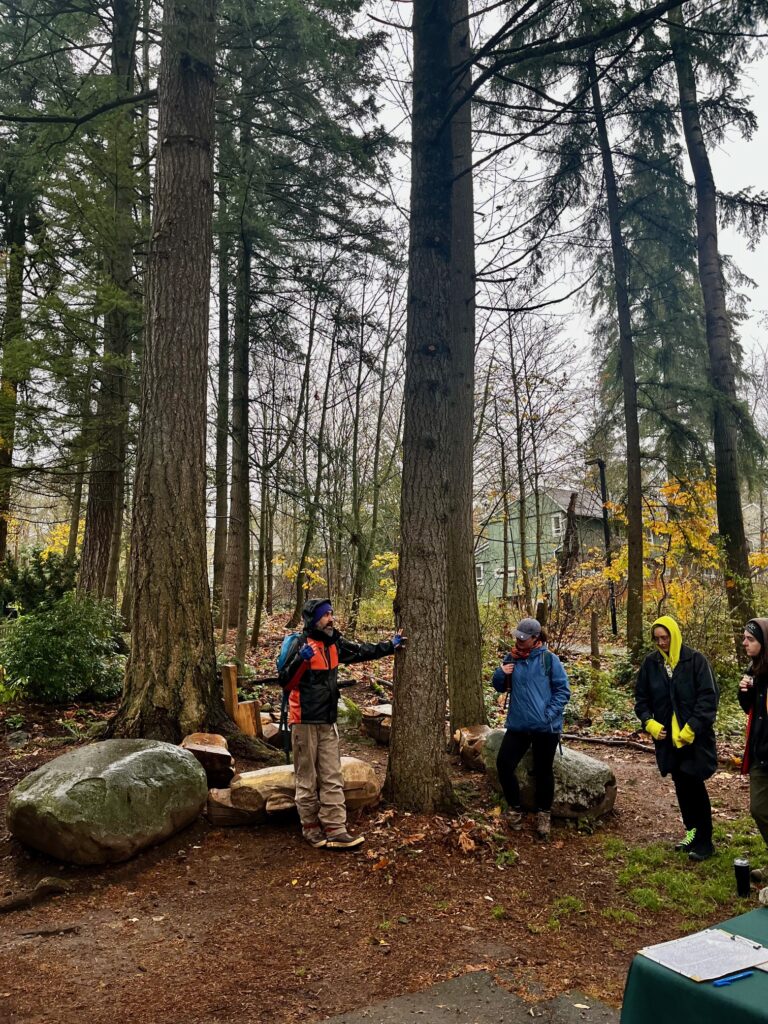
Douglas Fir
Willoughby began by welcoming everyone in the Douglas Fir Teaching Garden, pointing out that the Douglas Fir is a “tree of leadership” in the forest. It is the tree on the flag of our bioregion (Cascadia). The Douglas Fir partners with fungi for nutrient flows, electrical communication and more. Mycelium is the root-like structure of a fungus, made up of a mass of branching, thread-like hyphae. You can read Suzanne Simard’s book, Finding the Mother Tree to learn more about how trees are connected through these underground networks. There are approximately 2000 mushroom species that are mycorrhizal and associated with Douglas Fir trees. A single tree might have 200 unique mycorrhizal connections. An example of this is young Douglas fir trees, which are associated with truffle mushrooms.

Mushrooms as Food
In terms of mushrooms as food, Willoughby notes that they are an amazing source of fibre, amino acids, and vitamin D. They also have long chain sugars, which help our immune system adapt to stress. Willoughby added that, just last night, he had just had a 7 course meal with twelve friends, prepared using a variety of edible mushroom species.
Mushroom Reproduction
Mushrooms must mate. Spores create mycelium. If the spores drop in the right environment they will germinate into hyphae. Collectively, hyphae are all called mycelium. Mycelium is the “body” of the fungus, while the mushroom is the equivalent of the genetalia. Mushrooms are also referred to as the “fruiting body” or, more accurately, the “sporing body” (as they don’t produce fruit, but, rather, produce spores).
Mushroom Communication
How do mycelium find others in the soil? They branch out and meet others. They also use a form of communication. Humans use spoken language, but that is not the only type of communication. Fungi use “chemical communication”. They “smell” each other and grow towards each other. They can detect difference between other species & mating types (aka “sexes”). Some mushrooms have many mating types. For example, split gill mushrooms have 23,000 different mating types. So, they are very adaptable and resilient.
Then we began our walk down the Red Alder Trail in South Vancouver.

Some of the mushroom species that we came across were:
- Spreading Phlebia (Phlebia radiata)

Mushroom resembles vomit!
2. Candlesnuff Fungus (Xylaria hypoxylon)



Look like a snuffed out candle wick. If we notice wood going black that is caused by melanin, just like in our skin. Candlesnuff fungus grows from the wood, eating the wood without sofening it much. Note: a relative to this fungus is responsible for partially digesting wood that is used in the famous Stradivarius violin. The mushroom has the effect of giving the wood a better tone for the violin.
3. Purple jelly fungus (Ascocoryne sarcoides)
Squishy to the touch.
4. Gelatinous crust fungus (Exidiopsis effusa) – Possibly this species, but unsure

Willoughby discovered what might possibly be Gelatinous crust fungus on a fallen piece of wood. In freezing temperature with high humidity, Gelatinous crust fungus can create strands, called “hair ice” growing out of fallen sticks. These filament plumes of flexible ice crystals are beautiful and have a natural antifreeze property.
5. Artist’s Conk (Ganoderma applanatum)



Is a polypore, meaning it has pores instead of gills to release its spores. It is called an “artist’s conk”, as it turns white when you scrape the underside. However, Willoughby notes the most beautiful art he has seen was created by the mushroom itself. So, rather than calling it an “artist’s conk”, he says it should be referred to as “an artist” itself. Willoughby noted that the mushroom was growing out of the base of a Douglas Fir tree, that appeared wider on the base. This is a sign of “bottle butt” or “butt rot”, as the fungus is eating the wood of the lower trunk, weakening the wood at the base, causing it to become bottom heavy.
6. Common bonnets (Mycena sp):

Tiny mushrooms that often go unnoticed except by children
7. Cubical Brown Rot likely caused by Gloeophyllum sepiarium (Rusty Mazegill Polypore)

Seen in a piece of treated wood lying on the edge of the trail. It breaks down the wood into cubical shapes. This rotten wood stays in the soil for centuries. It holds onto nutrients in the soil.
8. Brittlestems (Parasola/Psathyrella sp. , possibly P. gracilis)
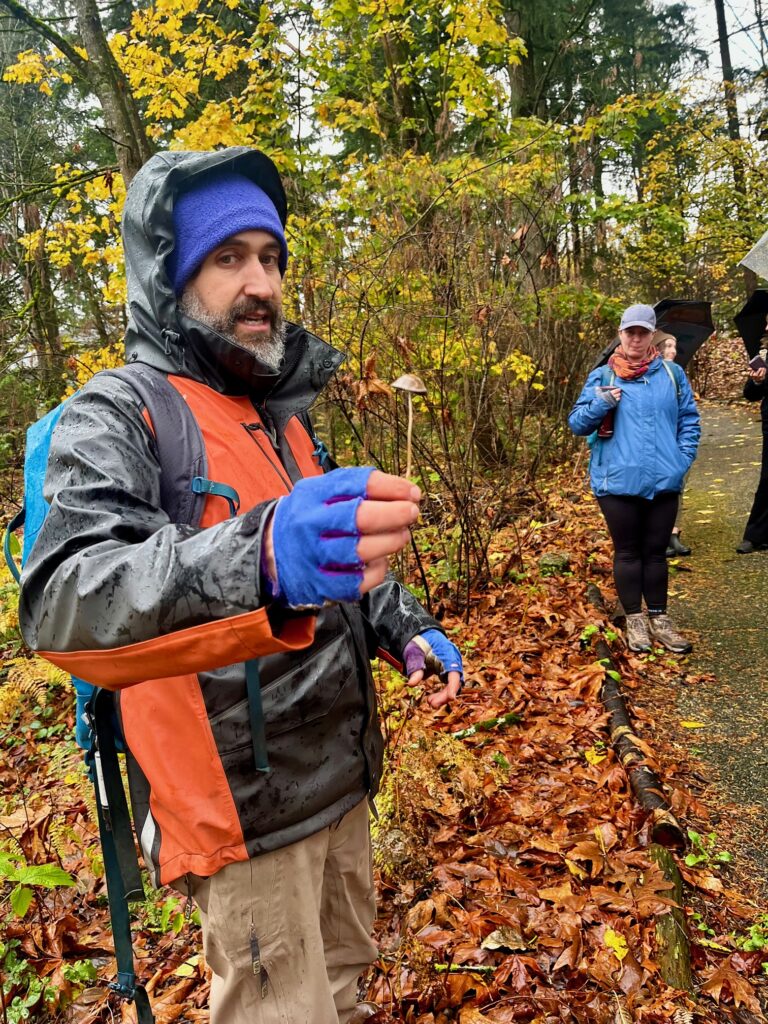
Thrives in leaf litter and is a soil decomposer. Brown, with a smooth cap.
9. Totally Tedious Tuboria aka. Scurfy Twiglet
(Tubaria furfuracea)



Brown, with mycelium. Nontoxic. Common in mulched areas.
10. Orange Jelly Spot (Dacrymyces stillatus)

11. Short jelly Antlers (Calocera viscosa)

12. Funeral Bell or Deadly Galarina (Galerina marginata)


We discovered this at the edge of the forest playground. Unfortunately, it is not an ideal one to have around young children, as it is a deadly mushroom. Bell-shaped cap, slightly pailer on the edge. Note: a similarly-appearing mushroom, wavy caps, are hallucinogenic and are often found near funeral bell mushrooms.
13. Brittle Cinder Fungus (Kretzschmaria deusta)

Seen at the base of a big leaf maple snag. The fruiting bodies were dead and appeared to be turning black, like cinder. This mushroom is a parasite of maples. The tree appears to be dead, but it is not dead. Hardwood can resprout from the base. Note: Coppicing is the traditional method in woodland management of cutting down a tree to a stump, which in many species encourages new shoots to grow.
14. Earth Ball or Poison Pigskin Puffball (Scleroderma citrinum)

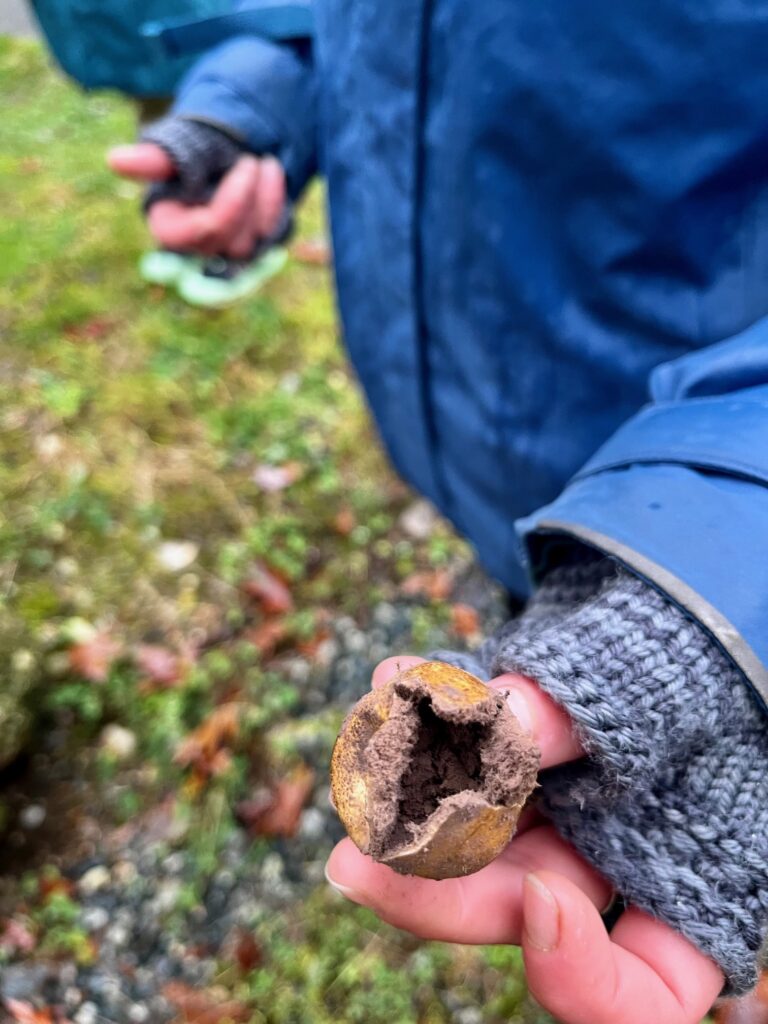
Has tough skin, dark purplish-grey spores. Different rom true puffball, are thicker and have more rubbery smell. Puffballs can also be eaten when young, while earth balls should not be eaten. Earth balls are dangaerous for dogs who are often attracked to them. Earth balls are an introduced species.
15. Witch’s Butter (Tremella mesenterica)

Orange jelly fungus that parasitizes other fungus. Edible and medicinal. Some refer to them as “forest flavoured gummy bears”. Unlike many mushrooms, they are edible raw. Used in traditional Chinese medicine, cultivated and dried. Used in soups for cooling properties and expelling excess dampness. Most Coastal Indigenous peoples did not traditionally eat mushrooms. However, Willoughby notes that Witch’s butter was eaten by Cowichan people, who refer to it like a “refreshing sip of water”.
16. White Fibrecap (Inocybe geophylla)
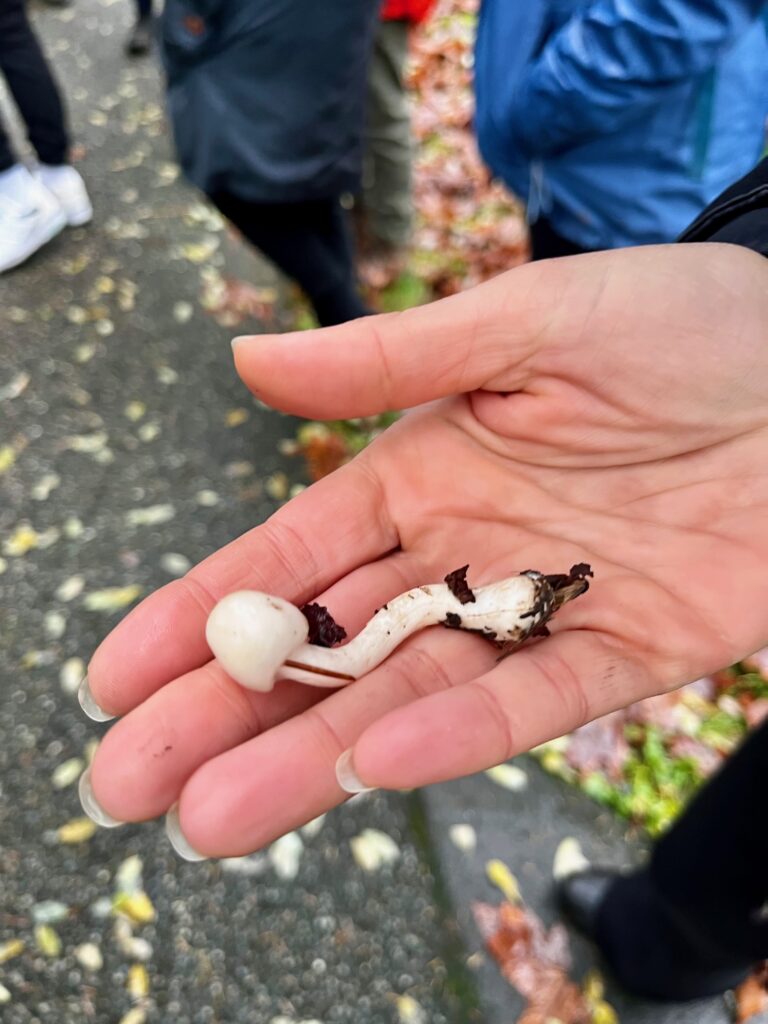
All Inocybe species are mycorrhizal and toxic, containing muscarine. Smell is a combination of a mushroom smell and sperm.
17. Turkey Tail (Trametes versicolo)

Edible. Too tough to be chewed raw. Edible in a broth or tea. Heavily perscribed cancer medicine in Asia.
Other Discoveries

We also discovered a wasp nest. Which was made when the wasps chewed up bits of wood from an adjacent fence and combined it with their saliva, which acted as a glue (similar to paper mache).

Eastern filbert blight is caused by the fungus Anisogramma anomala that only attacks Eurasian Hazelnut and not the native beaked hazelnut. It leaves black spots on the branches.
Willoughby pointed out lichen growing on a osoberry or Indigenous plum shrub. Lichen is a hybrid colony of algae or cyanobacteria living symbiotically among filaments of multiple fungi species, along with yeasts and bacteria embedded in the cortex or “skin”. Lichen are simultaneously organisms and ecosystems. To learn more about lichen, check out Ways of Enlichenment.
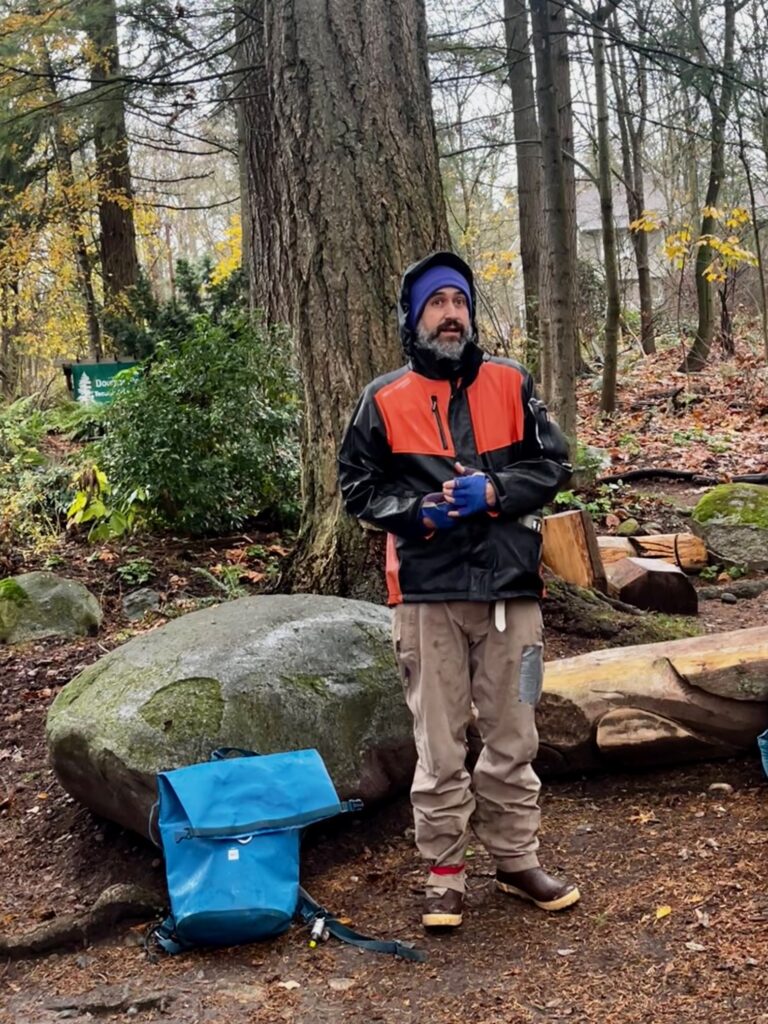
Thank you Willoughby for sharing your knowledge with us! Everyone was so engaged and learned so much! We hope to have you back for another walk next year.
Participants: Alyha, Autmn, Barbara, Chinonso, Cole, Grace, Hilary, Joshua, Kate, Larissa, Paula, Sherry, Sylvia, and Tom.